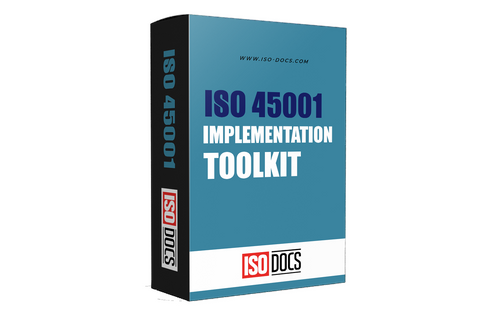ISO 45001 Incident Report Form Template
Introduction
The international standard on OHSMS that is aimed at assisting organizations to enhance the safety of their employees, minimize the risks at the workplace, and establish safer and improved working conditions is ISO 45001:2018. One major element in this standard is the proper reporting and handling of work related incidents such as injuries, illnesses, near-misses and nonconformities. Incident Report Form is an important resource in this process and it records necessary information required to investigate an incident, take corrective measures, and lead to the steady progress in occupational health and safety (OHS) performance.
The ISO 45001 Incident Reporting
Under the ISO 45001 Clause 10.2 (Incident, Nonconformity and Corrective Action), organizations should have in place processes to identify, report, investigate, and initiate corrective action of incidents. An incident is any event that occurs as a result of, or during work and may or may not lead to injury or ill health. Reporting of incidents in ISO 45001 is not just a political measure; it is a proactive and organized managerial method of protecting workers and improving the health and safety of the workplace.
ISO 45001 Incident Report Form Purpose
The incident report form helps the organization to:
-
Record essential Information: Include documentation on what, when, where and how in addition to who was injured, who witnessed and conditions of the surrounding environment.
-
Investigation Support: Support the root cause analysis and identification of contributing factors with factual evidence.
-
Facilitate Corrective Actions: Assign, Track and close corrective and preventive actions.
-
Keep up Compliance: Adhere to legal and regulatory reporting requirements and demonstrate when audited.
-
Fostering Communication: Report lessons learned to the involved interested parties, who include workers, the management and regulatory authorities.
- Promote Ongoing Improvement: Utilize incident data to revise risk assessment, refresh controls, and enhance safety management practices.
Important Elements Of An ISO 45001 Incident Report Form
Incident report forms differ with different organizations, but typically contain the following areas:
1. Basic Incident Information
Date and Time: The date the incident or its discovery.
- Location: The place or department the incident occurred.
- Incident Type: Injury, illness, near miss, property damage, environmental spill, etc.
- Incident Severity: Categories including minor, major, fatal and near-miss.
2. Persons Involved
- Name(s) and Contact Information: Injured worker(s), witnesses and third parties.
- Role and Department: Position occupied and area of work, assists in putting the incident in perspective.
- Injury or Ill Health, detail: What, where, symptoms, treatment given.
3. Description of the Incident
-
Narrative: An objective and factual account of the events as they took place.
-
Chain of Events: Step wise explanation to determine the course and sequence.
-
Witness Testimonies: Testimonies about the incident given by people who observed it.
- Photographs or Diagrams: Visual evidence of the scene, of hazard or equipment.
4. Initial Actions Taken
-
First Aid or Medical Treatment: Information on first aid given.
-
Site Safety Measures: Evacuation, elimination of hazards, cordoning of areas.
- Services to be Notified in case of an emergency: Police, fire brigade, ambulance (where needed).
5. Causes and Classification of Incidents.
- Immediate Cause: The immediate cause or action that leads to the incident.
- Root Causes: Systemic, procedural or behavioral causes of the incident.
- Hazard Identification: Hazard Type (mechanical, electrical, chemical, ergonomic, human factors).
- Risk Level Assessment: Impact/probability.
6. Corrective and Preventive Action.
- Actions Proposed: actions to remove root cause or minimize risks.
- Person Responsible: Person or team that will be in charge of implementation.
- Deadline to Be completed: Intended date of corrective action closure.
- Effectiveness Review: To guarantee success follow-up on the assessment.
7. Reporting and Sign-Off
- Report Prepared By: Name and date of Incident recorder.
- Checked By: Supervisor, safety officer or management representative.
- Communication: Record of the ways findings and lessons were disseminated to staff or others concerned.
Significance Of Incident Reporting In ISO 45001
1. Safe Worker Protections- The reporting of incidents promptly tackles the hazards to avoid future injuries or illnesses and lead to a safer workplace.
2. Satisfying Legal and Regulatory Adherence- Occupational health and safety laws across the world require the accuracy of records and investigations. Appropriate reporting saves organizations the costs of fines and litigations.
3. Government of Continuous Improvement- Incident data help organizations to read trends, outline systemic inefficiencies, and increase controls ahead of time.
4. Improvement of Organizational Culture- Encouragement of open reporting requires the development of a culture of accountability, practice and common dedication to safety.
5. Minimizing Costs- Companies save on time and financial losses associated with downtime, medical expenses, insurance and damage to reputation by preventing incidents and their escalation.
Problems In Operating Effective Incident Reporting
-
Underreporting: Fear, ignorance or excessive bureaucracy of the reporting process may deter reporting.
-
Unfinished or Misleading Reports: bad records create a drag to investigations and remedial measures.
-
Late Investigations: Lengthy response decreases the quality and efficiency of evidence.
-
Absence of Follow-Up: Reports will not be valuable without corrective measures.
- Cultural Barriers: The blame culture or low trust does not help in open communication of incidents.
Conclusion
One of the foundations of a good occupational health and safety management is the ISO 45001 Incident Report Form. When properly planned and used, it can be the best way to use workplace accidents as a priceless learning experience. Such reports help assemble key key information that serves as the basis of root cause investigation, corrective action strategy, and ongoing safety enhancement- ultimately employee protection, compliance with regulations and improved business resiliency.


